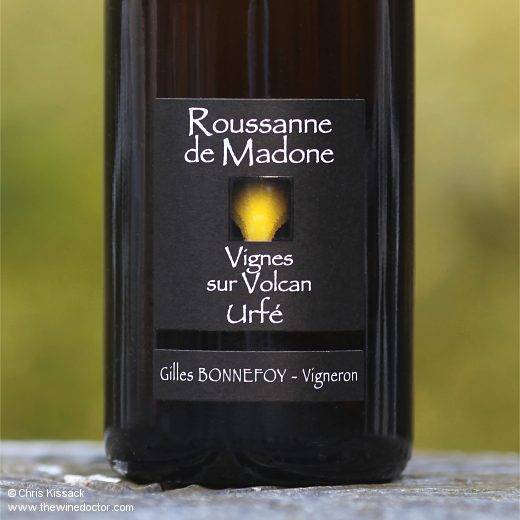Gilles Bonnefoy Roussanne de Madone 2020
One of the great joys in developing an understanding of the Loire Valley and its wines is exploring the more esoteric and arcane wines of the region’s more peripheral vineyards. Reports on mainstream Sancerre and Savennières are an important part of the job, but so is experiencing the multifaceted wines of Fiefs-Vendéens, the crystalline clarity of a good Jasnières, or the haunting lace-like texture of an off-dry Romorantin from Cour-Cheverny.
I struggle to think of any wines more arcane than those of Urfé, an Indication Géographique Protégée (IGP) created in 1979 to complement the (slightly) better known appellations of Côtes du Forez and Côte Roannaise. Both of those appellations are entirely focused on Gamay, whether it be rosé or red, but the region’s viticulture has historically been more diverse than this monocépage status might suggest. Pinot Noir has always been popular here, and there is Syrah too, the region’s vignerons not afraid to take inspiration from Burgundy and the Rhône Valley, both of which are a relatively short distance away. The vineyards of Côte Rôtie, for example, are just 85 kilometres south-east of here, somewhat closer at hand than Sancerre (200 kilometres north, if you’re interested) and Savennières (400 kilometres as the crow flies). And there are white varieties too, including Chardonnay, Viognier, Aligoté and Marsanne.
Not to mention Roussanne.

The name Urfé has an unusual origin; rather than opt for a geographically relevant moniker Urfé is instead named for one of the region’s most famous families, the residents of Château de la Bastie d’Urfé, in Forez. Honoré d’Urfé (1568 – 1625) was one of France’s most renowned novelists, responsible for L’Astrée, a lengthy account of the romance between the shepherd Céladon and the shepherdess Astrée, published in multiple volumes. Sadly Urfé did not bless us with as many wonderful ampelographic references as François Rabelais saw fit to do in Chinon, nevertheless his work is so intertwined with the culture and pastoral landscape of Forez it seems it was the obvious choice for the name.
It is not that long since I checked out the entry-level 2020 Côtes du Forez La Madone from Gilles Bonnefoy, so I figured it was about time I tool a look at one of his efforts in white. Gilles Bonnefoy made the decision to plant Roussanne back in 2001, using vines propagated by sélection massale, the original material coming from Savoie rather than the Rhône Valley. The vines are planted on a south-facing slope of basaltic soils with an incredibly steep slope, the gradient as high as 45% in parts. The fruit is hand-picked (no surprises there, on that slope) and fermented by indigenous yeasts, followed by partial malolactic fermentation. The yield in 2020 was just 30 hl/ha, giving Gilles barely 3,500 bottles to sell. In the glass the 2020 IGP Urfé Roussanne de Madone from Gilles Bonnefoy has a bright lemon gold hue, and this is matched by a nose brimming with tropical fruits led by melon, with a touch of poached pear sweetness. There follows an opulently styled palate, underpinned by a pretty and pithy backbone, the textural plushness through the middle leading to a quickly fading finish. It has plenty of primary charm, but the acidity feels rather low key, and it does not have the grip or structure that would give me the confidence to see how this would develop in bottle. I would choose to drink this rather endearing example of Roussanne over the next year or so. 88/100
Suitably inspired by this wine, this week I will continue with a sequence of reports, profiles and updates from the Upper Loire, kicking off tomorrow with a tasting report on the latest from Domaine Sérol, the wines tasted with Stéphane and Carine Sérol on two occasions during the past few months. (2/5/22)
Read more in:
- An early report on the Loire 2020 vintage
- A review of Gilles Bonnefoy Côtes du Forez La Madone 2020
- My profile of Gilles Bonnefoy
Find Gilles Bonnefoy IGP Urfé Roussanne de Madone 2020 on Wine Searcher: ![]()
